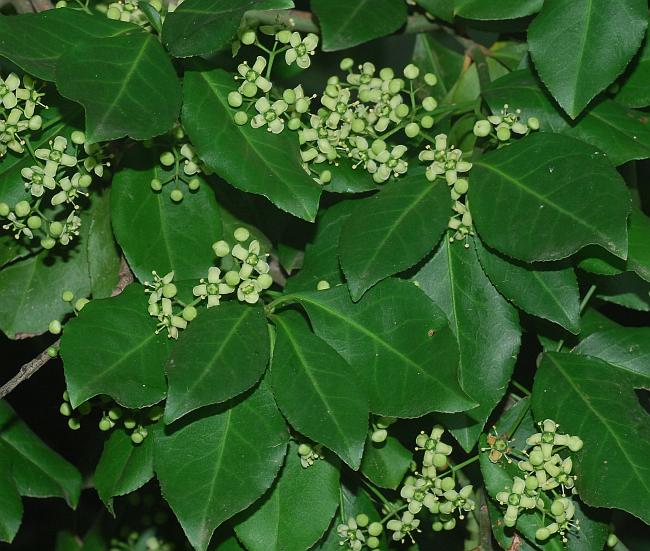Euonymus fortunei (Turcz.) Hand.-Mazz.
Wintercreeper

Introduced
CC = *
CW = 5
MOC = 21
© SRTurner
Euonymus fortunei (Turcz.) Hand.-Mazz.Wintercreeper | |
 |
Introduced CC = * CW = 5 MOC = 21 |
© SRTurner |
|
Family - Celastraceae Habit - Perennial lianas, rarely appearing as mounding shrubs. Stem - Spreading, trailing, or climbing, to 15 m or more, dimorphic, the spreading/ trailing phase exclusively vegetative, relatively slender, rooting at nodes, the climbing phase vegetative and often also reproductive, slender to more commonly relatively stout, adhering to the substrate by adventitious roots produced at and between nodes. Twigs green to grayish brown, circular in cross-section (but the older climbing stems often somewhat flattened or bluntly 3-angled).
Leaves - Opposite, simple, petiolate, thick and leathery, evergreen, short-petiolate, the petiole 5-10 mm long. Leaf blades dimorphic, those of the spreading, trailing phase 1-6 cm long, 0.5-3.0 cm wide, lanceolate to elliptic or ovate, angled or tapered at the base, angled or tapered to a bluntly or sharply pointed tip, the margins finely and bluntly to less commonly sharply toothed, the upper surface green to dark green, often with pale mottling along the main veins, the undersurface lighter green; those of the climbing, fertile phase changing to somewhat more herbaceous, 4-9 cm long, 2-5 cm wide, elliptic to broadly obovate-elliptic, tapered at the base, tapered to a usually sharply pointed tip, the margins finely and usually sharply toothed, the upper surface green to yellowish green and only occasionally slightly lighter along the main veins, the undersurface light green.
Inflorescences - Small axillary panicles of 5-15 flowers.
Flowers - Usually perfect. Sepals 4, 1.0-1.5 mm long. Petals 4, 3-4 mm long, 2-3 mm wide, nearly circular, white to pale greenish yellow, the margins usually entire. Stamens 4, these inserted along the margin of the nectar disc. Ovary usually with 1-5 locules and 2-6 ovules per locule. Style short, stout, the stigma entire or shallowly 3-lobed.
Fruits - Capsules 6-8 mm long, 2-4-lobed nearly their entire length, the valves smooth, straw-colored or occasionally slightly pinkish-tinged. Seeds 1-4 per locule, 4-6 mm long, enclosed in a fleshy red aril.
Flowering - June - August. Habitat - Bottomland and mesic forests, streambanks, gardens, fencerows, railroads, roadsides, disturbed areas. Origin - Native to Asia. Lookalikes - Mitchella repens, Vinca spp. Fruits resemble those of Celastrus spp. Other info. - In a list of the most noxious and invasive weeds of east-central Missouri, this species would probably occupy one of the top five slots. It probably occurs statewide (and is likely to be vastly underrepresented in collection records). It invades mesic and bottomland forests with a carpet of vines, choking out native growth. It climbs trees, smothering and breaking limbs with the weight of its growth. Its waxy leaves are impervious to many common herbicides. Once established it is impossible to eradicate. This species should never be planted deliberately. Photographs taken near Allenton Access, St. Louis County, MO, 7-31-2013, along the Katy Trail near Augusta, St. Charles County, MO, 11-6-2017, near Labadie, Franklin County, MO, 7-20-2020, and along Fox Creek, St. Louis County, MO, 7-29-2020 (SRTurner). |